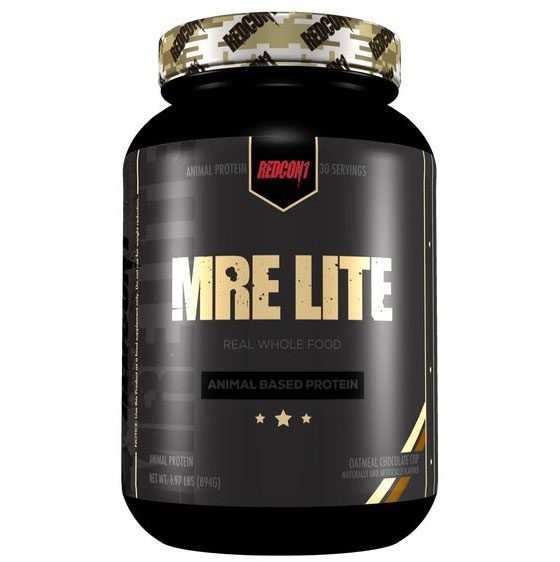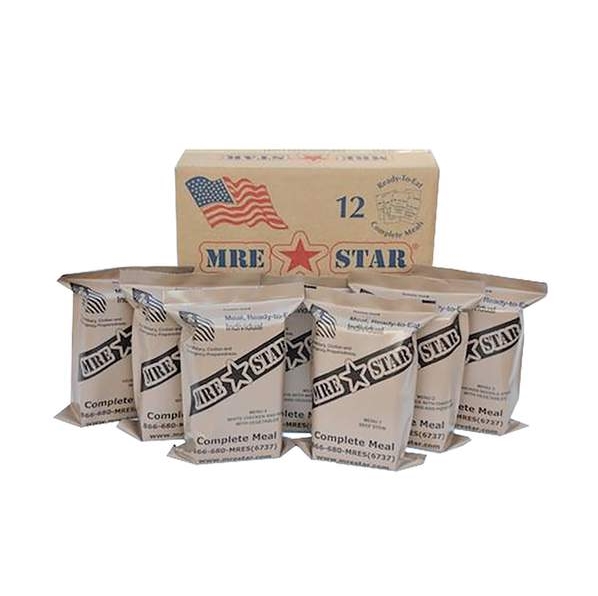Source: https://72hours.ca/collections/mres/products/mre-standard-complete-12-meal-case-with-heaters
MRE is an acronym for Meals Ready-to-Eat, and they are a special type of operational food rations that are normally used for military purposes due to their durability and high nutrition content. The type of food that is easy to pack and eat for a soldier who is always on the move and needs to be alert.
MRE has been around for ages, being heavily relied upon by the United States Army in particular. The food rations were first introduced during the second world war and later evolved into MCI (Meal Combat Individual) in the Korean and Vietnam wars. This further evolved into the current MRE that is still being used to this day.
Nutritional Value
The composition of an MRE varies, but they are made with great consideration for nutritional value while keeping their weight to a minimum. Basically, what this means is that every ingredient found inside a single pack of MRE has everything the body needs, with nothing going to waste. You bet to be full, and at the same time, your body gets the energy it needs. So what are some of the components of an MRE pack?
- Entree: This is the main course and contains food like spaghetti or beef stew.
- Side Dish: This ranges from corn, rice, mashed potatoes, or fruit, among other options.
- Bread: This could be the normal bread or other variations of it, including energy biscuits or crackers.
- Spread: This ranges from peanut butter, cheese spread, fruit jams to jelly.
- Dessert: This includes cookies, pound cakes, biscuits, and other small snacks that are both delicious and sources of energy.
- Candy: Sugar is equally important in the body, and this comes in the form of skittles, M&Ms, tootsie rolls, among many others.
- Beverages: Keeping the body hydrated is vital when on the move. MRE beverages usually range from cocoa, coffee, tea, dairy shakes, and Gatorade-based drinks.
- Seasoning: Some MREs come with hot sauces, although they are rare
- Flameless Heater: This is a special device that one can use to heat the entree if they happen to be in a very cold place.
- Accessories: This includes spoons, creamers, sugar, matches, toilet rolls, chewing gum, among many other things depending on the individual preferences.
On average, each MRE pack is able to provide a single person with 1250 calories which can be broken down into 13% protein, 36% fat, and about 51% carbs which form the bulk of energy giving foods that can be broken down easily.
Eating an MRE

Just as the name suggests, MRE are the type of meals that are ready to eat on the fly. Although the kit comes with heating devices, you may find yourself in a situation where the time for heating the food up is not there, but you still have to eat. The entrees taste much better when heated, but they are still palpable even when cold. An MRE pack can be eaten on the go without stopping, and this is what makes them the ideal meal for a soldier. There is no need for plates as the packets themselves double up as the eating containers, and once you are done, they can be thrown away. In a nutshell, MRE is a very convenient food for the most difficult of situations. Another option to get your daily nutrition is to consider a supplement like Balance of Nature.
How Long Do They Last?

Like most food rations, MRE is built to last since soldiers tend to find themselves in remote places where contact with civilization may be impossible. On average, MREs have a shelf life of about three years when stored in the right conditions, in this case, 80 degrees Fahrenheit. The lifespan can be lengthened or shortened depending on how they are handled. There are cases where some well-stored MREs can even hit 15 years without losing their taste or nutritional value; this is proof enough of how innovative this food concept is.
When Would I Need MRE?
When you consider their shelf life and how nutritional they are, MREs can come in handy for a number of extreme conditions that are briefly discussed below.
- Natural Disasters: Things like earthquakes, tsunamis, wildfires, and other big catastrophic events that have happened in the past have always resorted to MREs to keep the survivors well-fed quickly as there’s never any time for cooking.
- Quarantines: In the ongoing COVID-19 pandemic, stocking up on MREs is the best way to keep yourself isolated from the world as the food doesn’t go bad and has all the nutrients you need. You also don’t have to go through the hustle of cooking; some simple heating in the microwave could do the trick.
- Camping: When you go out camping. It doesn’t harm to go prepared with good MRE stocks. Although hunting is all about learning to be self-sustaining, carrying an emergency MRE pack will save you from the nightmare that may befall you if things go wrong while you are in the wild.
- Civil Unrests: the world has seen its fair share of riots in major cities around the world, and there are times when they can escalate to an all-out war that can make movements very hard. Venturing out to buy food may not be the best move in such a situation, and resorting to MRE stocks is the only way to sit this kind of situation out.
- Change in Diet: There is no written rule that forces people to eat a particular type of food every day. Switching the diet once in a while is a good thing, and MREs are not meant for emergencies only. You can set aside a few days in the week where you treat yourself to some MRE for a change.
Conclusion
There’s a lot about MREs that people don’t know about, and the most common misconception that’s prevalent is that it is food meant only for the military, and it doesn’t pack the same taste as normal fresh food. That’s not entirely accurate. If you are interested in knowing more about MRE and the many ways you can use them, check out 72hours.ca when you find some time.

A professional writer with over a decade of incessant writing skills. Her topics of interest and expertise range from health, nutrition and psychology.




